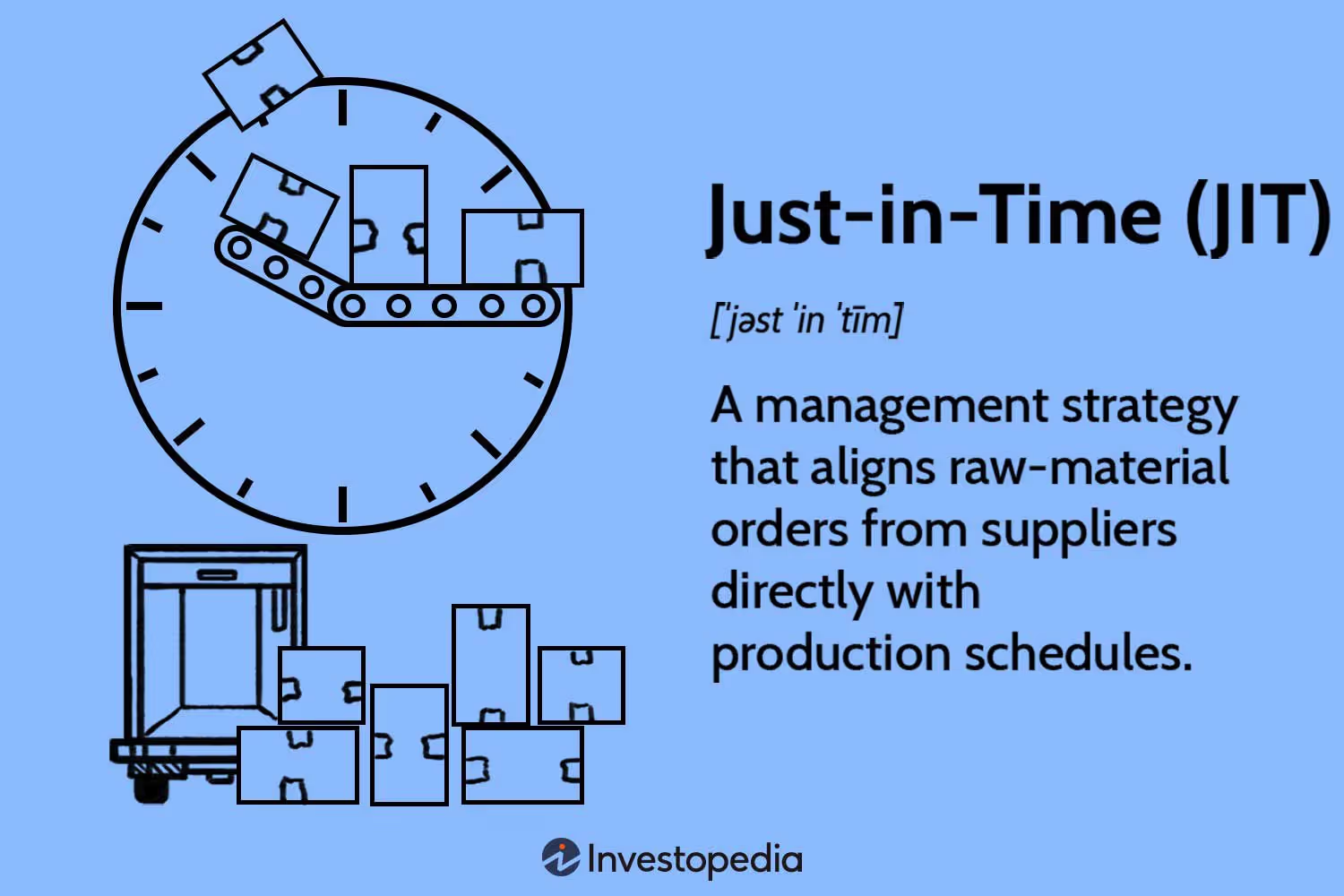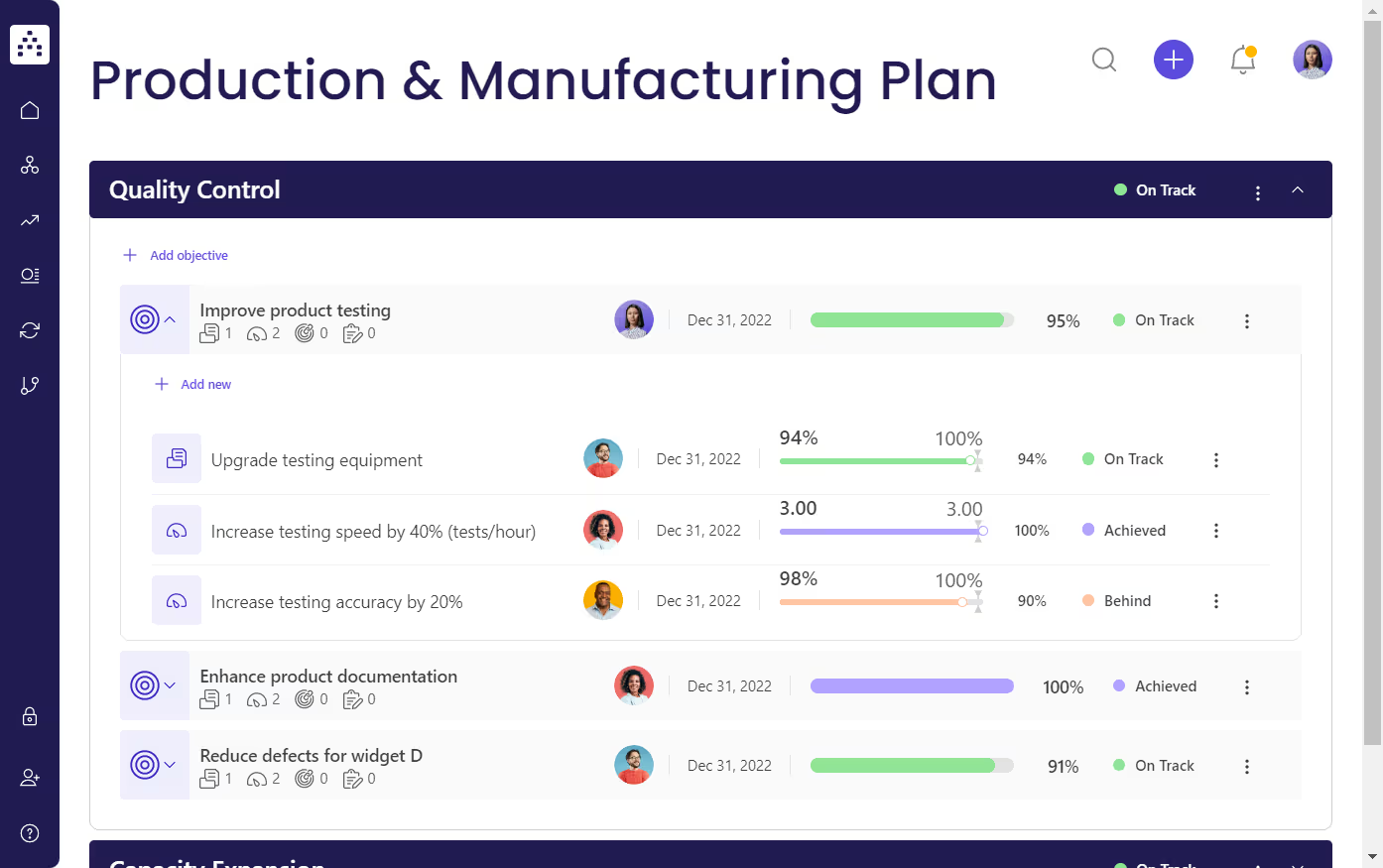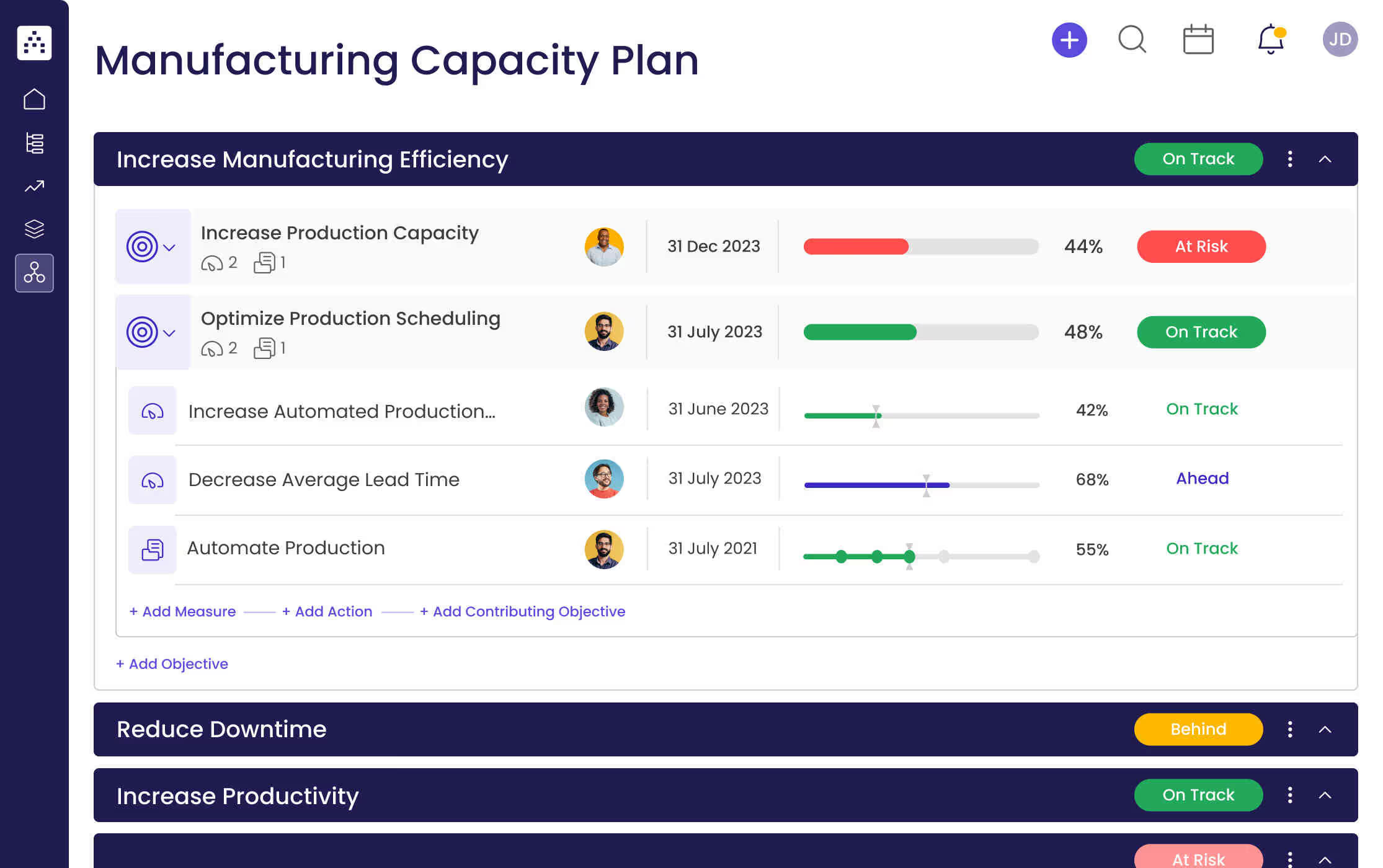Manufacturing companies need a rock-solid strategic plan to thrive in today's ultra-competitive business environment. But, let's face it, executing that plan with precision and consistency is where the real hustle begins.
According to Deloitte, “In 2024, manufacturers are expected to face economic uncertainty, the ongoing shortage of skilled labor, lingering and targeted supply chain disruptions, and new challenges spurred by the need for product innovation.”
But hey, with a solid plan in place and the ability to pivot on a dime, you can overcome these challenges and come out on top!
In this article, we'll explore the ins and outs of manufacturing strategy, from its key elements and benefits to best practices and success stories. And to make your life easier, we'll also hook you up with Cascade's manufacturing strategy templates—a powerful tool for crushing your goals!
What Is A Manufacturing Strategy?
A manufacturing strategy outlines how a company will use its resources to produce goods and services that meet the needs of its customers while achieving its financial goals. It involves a range of considerations, including the allocation of resources, the use of technology and equipment, the management of inventory and supply chains, and the optimization of production processes to achieve the company's overall business goals.
A well-designed manufacturing strategy can help a company optimize its operations, increase efficiency, reduce costs, improve quality, and ultimately increase profitability.
What Are The Key Elements Of A Manufacturing Strategy?
To develop an effective manufacturing strategy, a company must consider several key elements. While the specific goals, initiatives, and objectives may vary, some essential components are common to all successful strategies.
Product development and design
This involves creating products that meet customer needs while being produced efficiently. Key considerations include product features, specifications, functionality, and cost.
For instance, a company designing a new smartphone would need to decide on the size, weight, screen resolution, processing power, camera quality, and other features that meet the target market's needs.
Technology and equipment
Selecting and deploying appropriate manufacturing technology and equipment is crucial to manufacturing products efficiently and effectively. This includes deciding on equipment types, maintenance, and updates.
For example, an organization may invest in robotic equipment to automate its assembly line, resulting in faster and more accurate production and reduced labor costs.
Sourcing and management of materials
Identifying and sourcing raw materials and supplies are crucial components to ensure the efficient manufacturing of products. Key considerations include the quality, availability, and cost of the materials.
As an example, a company may source high-quality leather from a reliable supplier to produce premium leather bags.
Production processes and operations
Managing production processes and manufacturing operations is essential to ensure the efficient and effective manufacturing of products. Key considerations include resource use, labor management, and quality control.
A company may adopt lean manufacturing principles, for example, to optimize its production processes and eliminate waste, leading to reduced costs and increased efficiency.
Quality control and assurance
Implementing quality control and assurance measures ensures that products meet customer specifications and quality standards. Key considerations include testing, inspection, and continuous improvement.
A company may use statistical process control to monitor and improve product quality, resulting in fewer defects and higher customer satisfaction.
Inventory management and logistics
Managing inventory levels and logistics is essential to ensure products are available when and where needed. Key considerations include inventory control, order fulfillment, and supply chain management.
For instance, a company may use just-in-time inventory management to minimize inventory holding costs while ensuring on-time delivery to customers.
Continuous improvement and innovation
Continually improving and innovating manufacturing processes enhances efficiency, reduces costs, and improves product quality. Key considerations include the adoption of new technologies, process improvements, and customer feedback.
For instance, a company may use customer feedback to design and launch new products that meet evolving market needs, such as a smartphone with a longer battery life or a car with advanced safety features.
What Are The Benefits Of A Manufacturing Strategy?
A well-designed manufacturing strategy can offer numerous benefits to a company, including:
- Improved efficiency: Optimizing production processes can reduce costs and increase profitability by allowing a company to produce goods more efficiently.
- Increased flexibility: Responding to changes in demand or the market becomes easier with a strong manufacturing strategy in place, enabling a company to adjust production levels, product mix, or other factors as needed.
- Better quality control: Implementing quality control measures improves product quality, reducing inefficiencies, the likelihood of defects or product recalls, and enhancing customer satisfaction.
- Enhanced competitiveness: Manufacturing strategies can help companies produce goods more efficiently, offer better quality products, or deliver products more quickly than competitors, giving them a competitive edge in the marketplace.
- Improved supply chain management: Better supply chain management, achieved through a manufacturing strategy, can lead to cost savings and better customer service by reducing lead times and improving reliability.
- Greater innovation: Manufacturing strategies that focus on continuous improvement and innovation can help companies develop new products, processes, or technologies, which gives them a competitive advantage.
- Increased profitability: By improving efficiency, quality, flexibility, and innovation, a manufacturing strategy can help a company increase its profitability and growth potential.
6 Examples Of Manufacturing Strategies To Adopt
Companies can adopt several manufacturing strategies, depending on their specific goals, market conditions, and production processes. Let’s take a look at some examples!
Lean Manufacturing
This strategy aims to reduce waste, increase efficiency, and improve quality by streamlining production processes and eliminating non-value-added activities. Companies that use this approach focus on continuous improvement, employee empowerment, and the use of visual management techniques.
Toyota is a well-known example of a company that has successfully implemented lean manufacturing practices. The Toyota Production System (TPS) empowers employees to identify and eliminate non-value-added activities in the production process to reduce waste, increase efficiency, and improve quality.

Mass Customization
Producing customized products on a large scale using flexible production processes and advanced technology is the focus of this strategy. Companies that use this approach aim to meet the individual needs of customers while achieving economies of scale through efficient production processes.
Nike uses mass customization to offer a wide range of personalized products to customers. Nike's iD program allows customers to customize the colors, materials, and other features of their shoes, which are then manufactured and delivered within a few weeks.

Agile Manufacturing
Emphasizing flexibility, responsiveness, and innovation, this strategy enables companies to quickly adapt to changes in demand or new product opportunities. Companies that use this approach typically have highly automated production processes, advanced data analytics capabilities, and a culture of continuous improvement.
Apple is known for its agile manufacturing practices, which enable the company to quickly respond to changes in demand and introduce new products to the market. Apple's advanced supply chain management and manufacturing processes enable rapid scaling of production and response to changes in customer demand.
Total Quality Management (TQM)
To improve product quality and customer satisfaction, this strategy embeds quality control and assurance measures throughout the production process. Companies focus on process improvements, employee involvement, and data-driven decision-making to achieve higher levels of quality and customer satisfaction.
Ford has implemented a TQM strategy to improve product quality and customer satisfaction. Ford's Quality Operating System (QOS) focuses on continuous improvement, employee involvement, and data-driven decision-making to achieve higher levels of quality and customer satisfaction.
Just-in-Time (JIT) Manufacturing
To minimize inventory levels, reduce waste in the production process, and produce goods based on customer demand, this strategy is used. Companies aim to achieve higher levels of efficiency, reduce costs, and improve customer responsiveness by producing and delivering products quickly and reliably.
Dell is known for its use of just-in-time manufacturing practices, producing and delivering custom-configured computers quickly and efficiently. Dell's advanced supply chain management and manufacturing processes enable the company to produce and deliver products in a matter of days.

Green Manufacturing
This strategy revolves around bolstering sustainability by mitigating the environmental impact of production processes, minimizing waste, and optimizing resource efficiency. Companies aim to meet the growing demand for sustainable products and production processes while achieving cost savings through reduced energy use, waste reduction, and improved supply chain management.
Patagonia sets the benchmark as an exemplary company that has implemented green manufacturing practices to reduce its environmental impact. Patagonia's Worn Wear program promotes repairing and reusing clothing, reducing the amount of waste that ends up in landfills. The company also uses sustainable materials and production processes to reduce its environmental impact.

Jumpstart Your Manufacturing Strategy With Customizable Templates!
Developing a manufacturing plan from scratch can be a challenging task. To ease this burden, we have designed multiple templates that offer a systematic approach to creating a manufacturing strategy.
These templates are flexible and can be tailored to meet the unique needs of your manufacturing business.
Manufacturing Strategy Template

Develop a clear and effective manufacturing strategy with our Manufacturing Strategy Template, a comprehensive tool that helps organizations develop a clear and effective manufacturing strategy. Customize it to fit your business needs, covering inventory, production, quality, supply chain, and performance measurement.
👉 Click here to start building your own.
Production & Manufacturing Strategy Template

Get a comprehensive plan for your production and manufacturing processes. Improve processes, plan capacity, manage quality, and handle supply chain. It’s easy-to-use and adaptable to different organizations.
👉 Click here to start building your own.
Manufacturing Quality Plan Template

Our Manufacturing Quality Plan Template is ideal for companies looking to develop a quality plan for their manufacturing processes. It covers all aspects of quality management, including quality control, quality assurance, and quality improvement.
👉 Click here to start building your own.
Manufacturing Capacity Plan Template

Manage your manufacturing capacity with a detailed plan with this template covering all aspects of capacity planning, including forecasting demand, managing production schedules, and optimizing resource utilization. It’s pre-filled with examples and easily adaptable to your organization.
👉 Click here to start building your own.
Manufacturing Contingency Plan Template

Be prepared for contingencies in your manufacturing processes with this Manufacturing Contingency Plan Template. Identify potential risks, develop contingency plans, and implement measures to ensure your manufacturing business not only thrives but succeeds!
👉 Click here to start building your own.
Common Manufacturing Sub-Industries (+ Templates)
Manufacturing is a diverse industry with many sub-industries, each with its own unique characteristics and challenges. Some of the most common manufacturing sub-industries include pharmaceutical, food and beverage, industrial, metal and mineral, and computer and electronic product manufacturing. Depending on the sub-industry, manufacturing strategies can vary significantly.
Pharmaceutical manufacturing requires strict compliance with regulations and quality standards. A manufacturing strategy for this sub-industry would focus on quality control and regulatory compliance. To create a manufacturing plan for pharmaceuticals, use our Pharmaceutical Manufacturing Strategy Template.
Food and beverage manufacturing, on the other hand, requires compliance with food safety regulations. A manufacturing strategy for this sub-industry would focus on supply chain management and inventory control. To create a manufacturing plan for food and beverage products, use our Food and Beverage Manufacturing Strategy Template.
Industrial manufacturing encompasses a wide range of products, including machinery, tools, and equipment. A manufacturing strategy for this sub-industry would focus on efficiency and cost-effectiveness. To create a manufacturing plan for industrial products, use our Industrial Manufacturing Plan Template.
Metal and mineral manufacturing involves the extraction and processing of raw materials, such as iron and aluminum, into finished products. A manufacturing strategy for this sub-industry would focus on reducing waste and improving resource efficiency. To create a manufacturing plan for metal and mineral products, use our Metal and Mineral Manufacturing Strategy Template.
Lastly, computer and electronic product manufacturing requires constant innovation and adaptation to keep up with rapid technological advancements. A manufacturing strategy for this sub-industry would focus on research and development, as well as supply chain management. To create a manufacturing plan for computer and electronic products, use our Computer and Electronic Product Manufacturing Strategy Plan Template.
Execute Your Manufacturing Strategy With Cascade 🚀
Getting started with your Manufacturing Strategy is easy with Cascade. Here’s a step-by-step guide to set it up and use it for your organization’s planning:
1. Get your manufacturing strategy template
Getting started with your manufacturing strategy template is as easy as 1, 2, 3.
- Choose one of the manufacturing templates shared in this article and click on the link.
- Sign up for a free forever account in Cascade.
- Your template will automatically load on your Cascade workspace and be ready to use.
💡 Want to explore other templates? Check out our Strategy Template Library with over +1,000 free, ready-to-use templates.
2. Customize your template
Your template will feature prefilled focus areas, goals, actions, and metrics. But changing them is easy to do. You can tailor your strategy’s:
- Focus Areas
- Objectives
- End Dates
- Due Dates
- Project Titles
- KPIs
- Dependencies
Click on the items/title/metric or other variables you want to adjust to tweak them to fit your goals. If some variables align with your planning, keep them in, alter them, or add to them. Remember, this is your manufacturing strategy—make it your own!
3. Invite your team
Send an invite to your team members to collaborate on shared KPIs and ensure everyone is on the same page. With Cascade, you can assign roles and responsibilities, set up notifications, and communicate with your teams in one place.
4. Bring your data into one place
By connecting your existing data and inputs to your template, you can create a single source of truth for your plan and its execution. This provides unprecedented accuracy and control over the performance of your plan.
With Cascade’s +1,000 integrations, you can:
- Add collaboration tools like Teams, Slack, and Outlook.
- Integrate metrics and KPIs from Google Sheets, Excel, Jira, and Salesforce.
- Sync your plan, objectives, and their due-dates with your existing calendar in Google, Outlook, and iCalendar.
💡 Bonus Tip: If you have a custom integration requirement, contact our team, and we’ll help set it up.
5. Start executing the right way
Keep your plan from sitting idle for the rest of the year. You now have a living manufacturing strategy that can be shared and worked on in one place.
From here on out, you can add additional role players, set up teams for different projects, and track progress against projected outcomes.
If plans need to be adjusted, you can quickly make changes on the platform and update the entire team in one go.
💡 Bonus Tip: If you want to improve your manufacturing process, use Cascade’s key features to centralize your strategy execution for better and faster decision-making.
Reports: A simplified yet powerful approach to creating beautiful strategy reports on your progress. Spend less time finding data points and formatting and more time driving execution forward.
.png)
Dashboards: Set up custom dashboards to monitor execution as your teams work towards goals. Choose the metrics that matter to you and get real-time updates on how your teams move forward.
Timeline View (Roadmap): With the Timeline View feature, you can get a visual Gantt-style chart view of the Manufacturing schedule, complete with deadlines, priorities, and timelines.
Alignment Map: Build multiple plans in Cascade and visualize how they all work together to achieve your goals. You can easily see how your manufacturing strategy connects to your overarching business strategy or even to functional plans like your finance or marketing strategy.

The Key to Manufacturing Success: An Execution-Ready Strategic Plan
In the competitive world of manufacturing, having a solid strategic plan is essential, but it's only the beginning. The key to success is executing that plan flawlessly. That's where Cascade comes in to revolutionize the traditional approach to strategic manufacturing management and planning. With Cascade, you can turn your vision into an actionable and achievable plan that's ready to be executed.
So, if you're looking to take your manufacturing business to the next level, Cascade is the solution you’re looking for. Whether it's optimizing your production processes, streamlining your supply chain, or improving your quality control, Cascade can help you achieve your goals and maximize your performance.
Don't wait any longer to unlock your manufacturing potential. Book a guided 1:1 tour with one of our Cascade in-house strategy execution experts.






.png)
.jpg)
.jpg)
%20(1)%20(1)%20(1)%20(1)%20(1).png)



